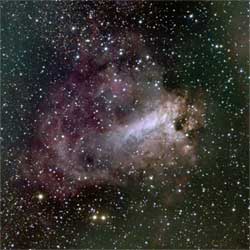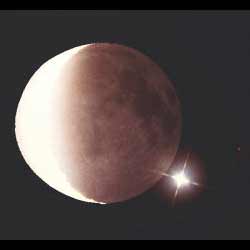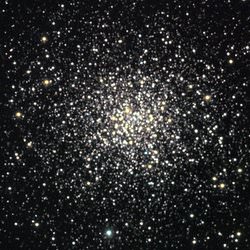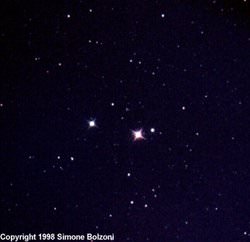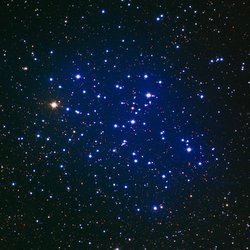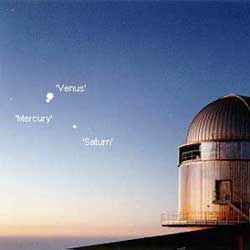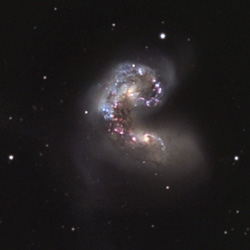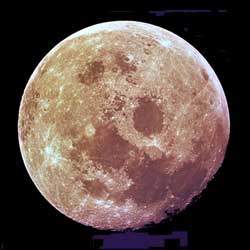
The Moon, captured by Apollo 11 astronauts. Image credit: NASA. Click to enlarge.
Monday, September 12 – If you’re up before sunrise this morning, be sure to step outside with a pair of binoculars and check out how close Saturn is to the M44. You should be able to see them both in the same field of view!
Today in 1959, the USSR’s Luna 2 scored a mark as it became the first manmade object to hit the moon. The successful mission landed in the Paulus Putredinus area, and tonight we’ll go there.
The most outstanding feature will be mid-placed Copernicus. Head northeast for Eratosthenes caught on the “tail” of the Apennine Mountains. To the northeast you will see prominent crater Archimedes with smaller craters Aristillus and Autolycus to the east. South of this pair, and caught along the mountain range, you will spy a dark grey, heart-shaped area known as the “Rotten Swamp” – Paulus Putredinus. Apollo 15 landed near Mons Hadley on its northeastern shore, but Luna 2 beat it there. Look at the area between the southern Autolycus and Archimedes. Spaseba!
Before we call it a night, why not point your scope toward the star in the northeast corner of the diamond of Delphinus? Its name is Gamma and it is one of the best double stars in this area for a small optics. Discovered by Struve in 1880, this 100 light year distant pair will show a slight yellow tinge in the fourth magnitude primary, and perhaps a little green in the fifth magnitude secondary. Enjoy it tonight…
Tuesday, September 13 – Today in 1922, the highest air temperature ever recorded at the surface of the Earth occurred. The measurement was taken in Libya burned in at a blistering 136?F, but did you know that the temperatures in the sunlight on the Moon double that? Tonight let’s take a look at a sunlit feature as we head for the bright point of crater Euler.
Beginning towards the north in the mostly disclosed Mare Ibrium region, look for this small, but conspicuous crater near the terminator. Note that it is roughly the same size as its two attendant craters to the east – Lambert and Pytheas, but has a noticeably central peak. If timing is right, you may be able to see the peak of Mons Vinogradov peeking above the terminator to its west.
For viewers in New Zealand, you will have the opportunity to watch the Moon occult Tau Sagittarius on this universal date. Please check this IOTA webpage for details.
If that’s not “hot” enough for you, then take a look straight overhead at brilliant star Vega. It is a “Sirian type” star and with a surface temperature of about 9200 degrees Kelvin, it’s twice as hot as our own Sun. At around 27 light years away, our entire solar system is moving towards Vega at a speed of 12 miles per second, but don’t worry… It will takes us another 450,000 years to get there. If we were to arrive tonight, we’d find that Vega is around 3 times larger than Sol and that it also has a 10th magnitude companion that can often be resolved in mid-sized scopes. It’s one of the first stars to ever be photographed. Back in 1850, that simple star – Vega – took and exposure time of 100 seconds through a 15″ scope. How times have changed!
Wednesday, September 14 – If you have a clear western horizon, take the time after the Sun sets to look at how far the evening planets have now moved apart. With Venus still blazing, Jupiter is becoming harder and harder to spot as it has moved a handspan away to the west. It’s almost gone…
Before we head off into the night, let’s take a look at the lunar surface. While outstanding Gassendi will catch the eye, there are more craters along the shores of Mare Humorum that deserve some attention! South of Gassendi and along the west shore is Class III crater Mersenius. Perhaps the terminator will be dividing it at the time of your viewing at it will appear like a “bite” taken out of the edge. Perhaps it will be well lit and you will see a cruciform structure of mountains and craters. Tonight its features look quite high, but by tomorrow, it will be totally washed out.
Due south of Gassendi across Mare Humorum is Doppelmeyer, who’s eroded walls have left it nothing more than a ghost of its former self – yet you can still see an upsweep in its interior landscape. If skies are stable, power up and see if you can spot Rimae Doppelmeyer to the west or the faded ruins of Puiseux on its eastern flank.
Thursday, September 15 – Head’s up, Eastern Europe! Tonight you have a chance to watch the Moon occult Epsilon Capricornii. Please check this IOTA webpage for details in your area.
Tonight on the lunar surface, we’ll visit the far north as well look towards our guidepost, Sinus Iridum. Head north once again to spot the rather unusual rectangle shape of crater Babbage. This ancient, shallow enclosure has many younger craters within it, and Babbage A will be quite clear. Heading northeast about twice the length of Babbage, you will spot a rather deformed “heart shape” that marks crater Anaximander. This will be part of a group of five overlapping craters, and the name is given essentially to the whole complex. Look for younger crater Carpenter as a black ellipse with a bright border intruding in its walls.
While you’re out, stop to look up at Beta and Gamma Lyrae, the lower two stars in the “Harp”. Beta is actually a quick changing variable which drops to less than half the brightness of Gamma in around 12 days. For a few days the pair will seem of almost equal brightness and then you will notice the star closest to Vega fades away. Beta is one of the most unusual spectroscopic stars in the sky, and it is possible that its eclipsing binary companion may be the prototype of the “collapsar”, (yep. a “black hole”!) rather than a true luminous body.
Friday, September 16 -The Moon rises shortly before Sun sets tonight amidst the difficult to see stars of the constellation Aquarius. Believe it or not, Uranus is only about 3 degrees away, but it will be next to impossible to pick the distant planet out with the lunar glare. So why ignore the Moon? Let’s do some exploring and we can start just as easily as identifying the grey oval of Grimaldi.
Just north of Grimaldi is Class V Hevelius. It will show as a bright oval, similar to Grimaldi, but will contain an off-center mountain peak. Its north wall is broken by Class I Calaverius, a narrow, bright ellipse with a thin, black border to the east. Only 100 kilometers away from here on the edge of Oceanus Procellarum lay the remains of the very first successful lunar landing. It was here on February 3, 1966 that the Soviet probe – Luna 9 – touched down. The man-sized craft sent back panoramic television images to a waiting Earth, revealing the uneven, jagged surface covered with dust. So good were the probe’s images, that scientists were even able to discern small depressions and protrusions only millimeters in size.
Saturday, September 17 – On this day in 1789, Sir William Herschel discovered Saturn’s moon Mimas. And indeed the Moon will be on our mind as tonight is “Harvest Moon”.
At exactly 10:01 p.m. EDT, the Moon will become Full and it will be the closest to the Autumnal Equinox. Because the orbit is more horizontal with the eastern horizon, it will rise a dusk for the next several nights in a row. On the average, the Moon rises about 50 minutes later each night, but at this time of year it’s around 20 minutes later for mid-northern latitudes and even faster farther north. Because of this added extra light, the name “Harvest Moon” came about because it allowed farmers more time to work in the fields.
Often times we perceive the “Harvest Moon” as being more orange than any other time of the year. The reason is not only scientific enough – but true. Coloration is caused by the scattering of the light by particles in our atmosphere. When the Moon is low, like now, we get more of that scattering effect and it truly does appear more orange. The very act of harvesting itself produces more dust and often times that coloration will last the whole night through. And we all know the size is only an “illusion”…
So, instead of cursing the Moon for hiding the deep sky gems tonight, enjoy it for what it is… A wonderful natural phenomena that doesn’t even require a telescope! Is that Mars following behind it?
Sunday, September 18 – If you’re up before dawn this morning, why not take the opportunity to step outside and look at how much the sky has changed. The winter constellation of Orion has now well risen and the harbinger of the Winter – Sirius – has now appeared.
Once again, the Moon will play a major role in tonight’s sky, but why not take the time to enjoy some of its incredible features? With just your eye you can identify Mare Crisium to the northeast, and Mare Fecundatitus to the southeast. Mare Frigorus is the long, dark stretch that runs across the northern section and the expanse of Mare Ibrium and Oceanus Procellarum dominate the northwest quadrant. Can you spot the dark oval of Mare Humorum to the southwest or Nubium to its east?
Those of you with sharp eyes might be able to make out the small dark oval of crater Plato to the north or Grimaldi to the west. Can you see the bright point of Tycho? Just north of central is the very round, grey Mare Serenitatis and south of it, Mare Tranquillitatis. Using binoculars, trace out the bright rays of Proculus in the east and Tycho to the south. Aristarchus and Kepler shine like beacons in the northwest and while the southwest is far more muted, look for the bright point of Euclides.
Hang tough. A few more days and darker skies will be on our side! Until then? May all your journeys be at light speed…. ~Tammy Plotner

